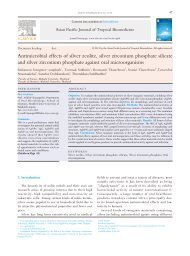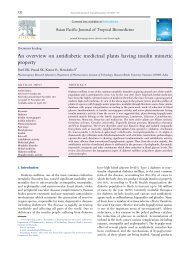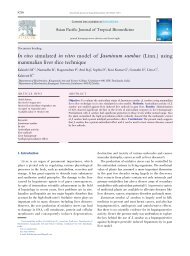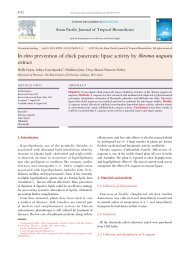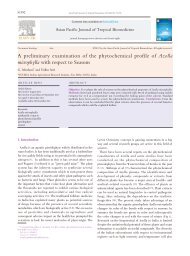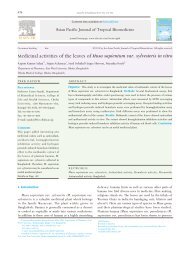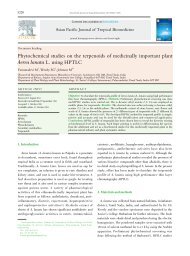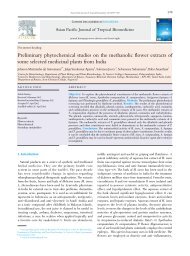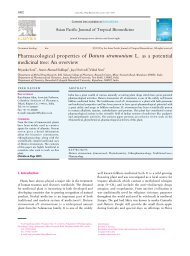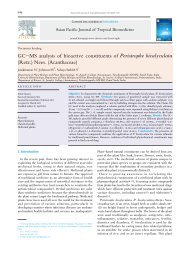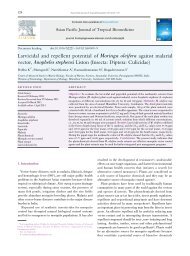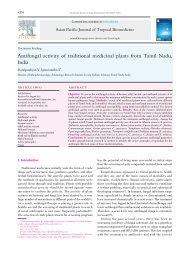Therapeutic potential of Terminalia chebula Retz ... - Apjtb.com
Therapeutic potential of Terminalia chebula Retz ... - Apjtb.com
Therapeutic potential of Terminalia chebula Retz ... - Apjtb.com
Create successful ePaper yourself
Turn your PDF publications into a flip-book with our unique Google optimized e-Paper software.
250<br />
a drug development programme should be undertaken to<br />
develop modern drugs with the <strong>com</strong>pounds isolated from<br />
T. <strong>chebula</strong> effective against different types <strong>of</strong> diseases<br />
and also to over<strong>com</strong>e the problem <strong>of</strong> drug resistance after<br />
extensive investigation <strong>of</strong> its bioactivity, mechanism <strong>of</strong><br />
action, pharmacotherapeutics, toxicity and after proper<br />
standardization and clinical trials.<br />
Conflict <strong>of</strong> interest statement<br />
We declare that we have no conflict <strong>of</strong> interest.<br />
Acknowledgements<br />
Authors wish to acknowledge the Head, Agricultural<br />
and Ecological Research Unit, Indian Statistical Institute,<br />
Kolkata, India for her kind help and cooperation during<br />
this work and also Pr<strong>of</strong>. T. K. Basu, former Head, Biometry<br />
Research Unit, Indian Statistical Institute, Kolkata, India<br />
for critically going through the manuscript.<br />
Comments<br />
Background<br />
This is a review paper on the benefits <strong>of</strong> T. <strong>chebula</strong><br />
as an alternative medicine for many diseases. The<br />
pharmacological effects exhibited by this plant have been<br />
elaborated in depth with citations from studies that have<br />
been conducted using this Ayurvedic plant.<br />
Research frontiers<br />
There is no lab experiment being done in this manuscript<br />
since it is a review paper. However, the author cited latest<br />
and recent publications on works done in this particular<br />
field, in which bring the readers to the recent analytical<br />
approach for pharmacological <strong>potential</strong> <strong>of</strong> this plant.<br />
Related reports<br />
The author cited different papers in his manuscript<br />
to support the therapeutic <strong>potential</strong> <strong>of</strong> T. <strong>chebula</strong> in<br />
traditional medicine. Past studies mostly presented the<br />
pharmacological activities <strong>of</strong> this plant done in vitro and in<br />
vivo.<br />
Innovations and breakthroughs<br />
This review paper is one <strong>of</strong> its own in which it<br />
summarizes any research that have been conducted on T.<br />
<strong>chebula</strong> specifically in medicinal field. It is a good source<br />
<strong>of</strong> literature survey for researchers who intended to do<br />
studies in this particular field, and using this plant.<br />
Applications<br />
This paper could be applied by most Ayurvedic<br />
practitioners in their medication activities to treat patients<br />
with different types <strong>of</strong> diseases.<br />
Peer review<br />
This paper is a good review paper on Ayurvedic and<br />
pharmacological activities <strong>of</strong> T. <strong>chebula</strong>. Citations used are<br />
also a good resources for reviewing and very informative to<br />
all the Ayurvedic and traditional practitioners.<br />
Anwesa Bag et al./Asian Pac J Trop Biomed 2013; 3(3): 244-252<br />
References<br />
[1] World Health Organization. Traditional medicine-growing needs<br />
and <strong>potential</strong>. WHO policy perspectives on medicine, No. 2. WHO/<br />
EBM/2002. WHO: Geneva; 2002.<br />
[2] Koehn FE, Carter GT. The evolving role <strong>of</strong> natural products in<br />
drug discovery. Nat Rev Drug Discov 2005; 4: 206-220.<br />
[3] CSIR. The wealth <strong>of</strong> India - A dictionary <strong>of</strong> indian raw materials<br />
and industrial products. Vol X. New Delhi: Publication and<br />
Information Directorate, CSIR; 2002, p. 522-524.<br />
[4] Varier. A dictionary <strong>of</strong> Indian raw materials and industrial<br />
products. New Delhi: Publications and Information Directorate,<br />
Council <strong>of</strong> Scientific and Industrial Research; 2002, p. 387.<br />
[5] Khare CP. Indian medicinal plants: An illustrated dictionary.<br />
Berlin: Springer-Verlag; 2007, p. 652-653.<br />
[6] Govt. <strong>of</strong> India. The Ayurvedic pharmacopoeia <strong>of</strong> India. New Delhi:<br />
Government <strong>of</strong> India Ministry <strong>of</strong> Health and Family Welfare<br />
Department <strong>of</strong> Indian System <strong>of</strong> Medicine & Homoeopathy; 2001,<br />
p. 47, 143.<br />
[7] Gupta AK, Tandon N, Sharma M. Quality standards <strong>of</strong> Indian<br />
medicinal plant. New Delhi: Indian Council <strong>of</strong> Medical Research;<br />
2003, p. 207-209.<br />
[8] Sukhdev SH, Deepak M, Joseph GVR, Joseph S, Nagar G. Indian<br />
herbal pharmacopoeia. Vol II. Jammu Tawi: IDM, Mumbai and<br />
RRL, CSIR; 1999, p. 154-159.<br />
[9] Aslokar LV, Kakkar KK, Chakre OJ. Glossary <strong>of</strong> Indian medicinal<br />
plants with active principles. New Delhi: Publications and<br />
Information’s Directorate, CSIR; 1992.<br />
[10] Kumar A, Lakshman K, Jayaveera K, Satish K, Tripathi SM.<br />
Estimation <strong>of</strong> rutin and quercetin <strong>Terminalia</strong> <strong>chebula</strong> by HPLC.<br />
Int J Aesth Antiag Med 2009; 2(1): 3.<br />
[11] Jayaramkumar K. Effect <strong>of</strong> geographical variation on content<br />
<strong>of</strong> tannic acid, gallic acid, chebulinic acid, and ethyl gallate in<br />
<strong>Terminalia</strong> <strong>chebula</strong> fruits. Nat Prod 2006; 2(3-4): 170-175.<br />
[12] Juang LJ, Sheu SJ, Lin TC. Determination <strong>of</strong> hydrolyzable tannins<br />
in the fruit <strong>of</strong> <strong>Terminalia</strong> <strong>chebula</strong> by high-performancc liquid<br />
chromatography and capillary electrophoresis. J Sep Sci 2004;<br />
27(9): 718-724 .<br />
[13] Williumson EN. Major herbs <strong>of</strong> Ayurveda. London: Churchill<br />
Livingstone; 2002, p. 299.<br />
[14] Tubtimdee C, Shotipruk A. Extraction <strong>of</strong> phenolics from <strong>Terminalia</strong><br />
<strong>chebula</strong> <strong>Retz</strong>. with water-ethanol and water-propylene glycol and<br />
sugaring-out concentration <strong>of</strong> extracts. Sep Puri Tech 2011; 77(3):<br />
339-346.<br />
[15] Thakur M, Rana RC, Thakur S. Physiochemical evaluation <strong>of</strong><br />
<strong>Terminalia</strong> <strong>chebula</strong> fruits. J Non Timber Forest Prod 2008; 15: 37-<br />
42.<br />
[16] Rangsriwong P, Rangkadilok N, Satayavivad J, Goto M, Shotipruk<br />
A. Subcritical water extraction <strong>of</strong> polyphenolic <strong>com</strong>pounds from<br />
<strong>Terminalia</strong> <strong>chebula</strong> <strong>Retz</strong>. fruits. Sep Puri Tech 2009; 66: 51-56.<br />
[17] Muhammad S, Khan BA, Akhtar N, Mahmood T, Rasul A, Hussain<br />
I, et al. The morphology, extractions, chemical constituents and<br />
uses <strong>of</strong> <strong>Terminalia</strong> <strong>chebula</strong>: A review. J Med Plants Res 2012;<br />
6(33): 4772-4775.<br />
[18] Yoganarasimhan SN. Medicinal plants <strong>of</strong> India. Bangalore: Self<br />
Publication; 2000, p. 541.<br />
[19] Zhang X, Chen C, He S, Ge F. Supercritical-CO 2 fluid extraction<br />
<strong>of</strong> the fatty oil in <strong>Terminalia</strong> <strong>chebula</strong> and GC-MS analysis. Zhong<br />
Yao Cai 1997; 20(9): 463-464.<br />
[20] Mammen D, Bapat S, Sane R. An investigation to variation in<br />
constituents in the fruits <strong>of</strong> <strong>Terminalia</strong> <strong>chebula</strong> <strong>Retz</strong>. at different<br />
maturity stages. Int J Pharm Bio Sci 2012; 3(1): 416-419.<br />
[21] Han Q, Song J, Qiao C, Wong L, Xu H. Preparative isolation<br />
<strong>of</strong> hydrolysable tannins <strong>chebula</strong>gic acid and chebulinic acid<br />
from <strong>Terminalia</strong> <strong>chebula</strong> by high-speed counter-current



